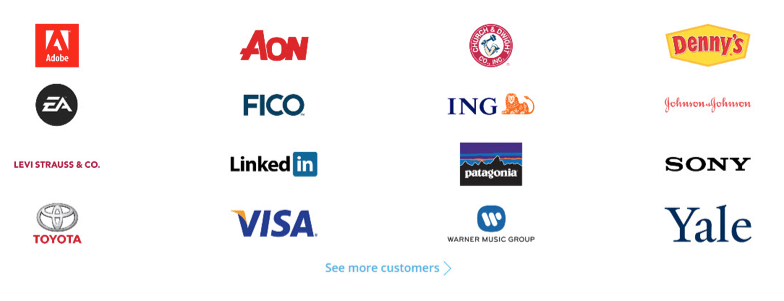It’s 3 a.m. You’ve got a wicked case of insomnia and are watching infomercials. You’ve spent 20 minutes watching an infomercial about steak knives. They slice; they dice; they never dull or rust. You need these knives in your kitchen.
The phone number comes up on the screen, and the perfectly trained announcer voice says, “If operators are busy, please call again.”
Does this turn you off or make you more anxious to get through and place your order? Surprisingly, most people are more anxious to call and place their order after hearing this call-to-action. Why? Because it triggers the principle of social proof or principle of consensus.
Social proof is a psychological phenomenon where we are influenced by and conform to the actions of others. We find out what others are doing before making a decision. We watch those around us, modeling our behavior after them. We match the actions of others automatically and unconsciously.
TV writer Colleen Szot is responsible for the infomercial line about operators being busy. She purposefully added it to infomercial scripts to trigger the viewer’s need for social conformity, and it worked like a charm. Now, it’s used all the time. Whether we consider ourselves leaders or followers, trendsetters or traditional, our brains are wired to match the actions of others in order to display the correct behavior. We are all influenced by what other people are doing.
Understanding this concept and how it affects the workplace is extremely important. Your employees spend 40 hours a week together in the same office, so their influence on one another shouldn’t come as a surprise. What you do with this information is what will make you stand out.
As a leader, you can use social proof to benefit your team. By understanding how this principle functions within your workplace, you can influence your team and shape how employees influence one another. My recent post Persuasion at Work touched on this concept. This article is going to delve deeper into the subject of motivating your employees using use social proof, but first, let’s do a recap.
Social Proof Recap
Social proof is one of the seven principles of persuasion that Robert Cialdini covers in the two books every manager should read: Influence and Pre-Suasion. Watching our peers to know how to behave is natural. We constantly, unconsciously look for evidence of what others think, feel and do so we know what to do and how to respond. Although we worry that we’re influenced by marketing and advertising, the reality is we are far more influenced by our peers than anything we see on TV or read online. You can see evidence of social proof even in your life as an adult.
- Testimonials and case studies. When trying to figure out whether a company or product is good or reliable, we tend to believe testimonials and case studies more than what the company says because we view those as coming from our peers. If the recommendation is from someone we know, even better.
- Gold stars. As kids, gold stars proved to us and those around us where we were in a subject compared to those around us, and usually said we were above average. Gold stars exist in the adult world; they’re called badges.
- Emergency Situations. In emergency situations, we look at the people around us to know if everything is under control or not. The cues we see dictates how we respond. A great example of this is the infamous murder of Kitty Genovese where more than 30 people witnessed the attack and did nothing to stop it.
- Hesitation in answers. As children in school, we hesitated to raise our hand to answer a question, checking to see if anyone else was going to raise theirs. We didn’t want to stick out. As adults, we don’t have to raise our hands, but we look around and wait to see if anyone is going to answer. We still don’t want to appear different.
Social proof is one of the easiest psychological principles of influence to identify in our everyday lives because we can see it impacting every decision we make throughout the day. It’s different from peer pressure in that it’s unconscious and totally self-motivated. We aren’t forced to conform to social norms; we want to.
This drive to conform means that social proof is happening in your workplace, for good or bad, regardless of whether you’re aware of it or not. Since it’s already in place, we’re going to teach you how to use it to motivate your employees, improve employee engagement, and create an all-around happier workplace.
Walk Your Talk
By far, the most important thing you can do in your workplace to motivate your employees using social proof is walk your talk. Do what you’re asking them to do. Model the behavior you want to see.
The concept is nothing new. It’s used in television all the time. Have you ever stopped and thought about laugh tracks on TV sit-coms? It’s background noise to most of us, but I challenge you to pay attention to it the next time you watch a sit-com. It’s canned laughter. You know that TV executives purposefully added it to the soundtrack of the show. No live audience is there laughing at the characters’ jokes, yet the track still causes us to laugh along with it.
A laugh track is a behavior model. Those TV executives want to provoke laughter because studies have shown that when people laugh, they rate the material as funnier. A funnier show, of course, will get higher ratings. Hearing other people laugh triggers the social proof principle, and we laugh too. It’s instinctive.
An example of how behavior modeling works here at Axero is in company intranet usage.
The question often arises, “How do you launch the intranet in your workplace?” However, the real question is, “How do you get your employees to use the intranet?” Our answer is, “Get buy-in from higher-ups, and get them to use it first!” We’ve seen this work, and the principle of social proof helps us understand why: Employees mimic your behavior far more than they follow a set of rules.
Let’s say you want to change the dress code at your workplace. You want your employees to wear business-casual clothing instead of shorts and t-shirts. Start the change by changing what you wear first. Any other approach will cause the dress code to be questioned. And if you’re not following it yourself, the dress code will be completely ignored eventually. You know this intuitively, and now you know the psychological principle behind it, and knowledge gives you power that you can apply elsewhere.
- How do you get your employees to arrive to meetings on time? Always be on time yourself.
- How do you get employees to fill out their end-of-year review forms before the deadline? Always meet deadlines yourself.
- How do you get employees to feel confident about their roles in the organization? Be confident in your role as a leader, and model the behavior you know will help your organization move toward its goals.
The concept of behavior modeling becomes especially important in times of uncertainty.
Social conformity is present in every situation of life, but it rears its head more intensely during times of uncertainty. Consider how when a young child falls and skins the knee, the child first looks for a nearby parent before deciding whether to cry or not. Similarly, when uncomfortable change comes knocking on the door of your organization, your employees look to you for how to react.
Cialdini discusses this idea with regard to the Jim Jones mass suicide, which happened shortly after the cult moved to Guyana, in his book Influence. The group as a whole was likely feeling very uncertain, and following the crowd probably felt like the most appropriate action. Many psychological elements were probably at play, but in any cult situation, social proof is a strong influence. Add to social proof the element of uncertainty, and you’ve got a recipe for disaster.
Apply what you’ve learned above during times of organizational change. Remember that you are in the spotlight at all times, but especially during changing times. Your employees are watching you to see how they should react. Take time to reassure them.
Here are three ways to do this:
- Write a blog post about the change, and explain the positive benefits you believe you’ll see from it.
- Prominently display recently won team awards and recognition on the team intranet page. Your team will see that you recognize their value, and they might start focusing more on their value, too.
- Share market trends you see that would reassure employees of their important roles within the company.
Most importantly: Stay calm, be positive and focus on what you can do to move forward during times of change. Model the behavior you want to see in your employees.
Share What Others Are Doing
Knowing what you do about social proof now, which of the following statements do you think would be more likely to encourage your employees to fill out paperwork?
- “71% of you have filled out the paperwork already. Thank you!”
- “29% of you still haven’t filled out the paperwork.”
If you picked number one, you’ve been paying attention. With that statement, employees know that their peers have been filling out the paperwork, and remember, we look to our peers for indications of how to act. (Sheila Heen talks about this much more in-depth in her book, Thanks for the Feedback: The Science and Art of Receiving Feedback.)
Why is Toastmasters so successful at helping people overcome their fear of public speaking? Because members observe their peers bravely getting up in front of the room and speaking, so they know they can do the same. Why are we more likely to sign a petition that has 100 names on it already? Because we see that others have already taken that action, so it must be socially acceptable. Why do nightclubs make people wait in line outside before being granted access? Because when passersby see a line of people outside of the club, they perceive it as popular.
In Influence, Cialdini cites a study that was conducted with hotel visitors to figure out a more effective way to get them to reuse towels. Guests were presented with one of four signs:
- A statement of the environmental benefits of reusing towels.
- A promise to donate to an environmental charity.
- A note that the hotel has already donated to a charity, and they are hoping for help.
- A message that most guests reuse their towels at least once during their stay.
Which one do you think got the best results? If you guessed number four, you’re on fire! Yes, when guests were told that other people reused towels, they were much more likely to reuse towels themselves. They were influenced by the social proof of other hotel guests.
In your workplace, your employees are already looking to their peers for cues, so give them a head start. Point out the employees in your organization who are exhibiting behavior you want to encourage.
The way marketers often this is through counter widgets. They are graphic boxes which show how many people have bought a product or subscribed to a mailing list or viewed a video, etc. Counter widgets show potential buyers that others have bought before them, triggering social proof and sometimes even triggering the dreaded FOMO (fear of missing out).
Counter widgets are a powerful tool that you can adapt to your workplace using the intranet. Simply add a badge to your team page showing how many people have taken a certain action.
Remember that the principle of peer activity is especially important when hiring and onboarding new employees. Being the newest member of the team is a surefire source of uncertainty. The newcomer doesn’t know anyone, and no one knows him or her. The newbie doesn’t know the social norms, the business rules, or even his or her responsibilities yet. Looking to the other employees for cues as to how to act and what to do is the norm.
You can see why social proof comes into play so strongly in the above scenario. You can probably also see why it’s so important that you, as a manager or leader, shape that social proof as much as possible. Set the new employee’s expectations, but do it honestly. This is your first opportunity to build trust with them.
- Highlight the positive norms instead of pointing out the negative behaviors you want them to avoid.
- Share some of the team members’ wins: a project success, a big accomplishment, a work anniversary, volunteer efforts, etc.
- Whatever you do, don’t lie. Don’t even stretch the truth. You risk making the new employee feel like he doesn’t belong. For example, don’t tell the new hire that everyone goes to lunch at noon when the truth is everyone leaves at 11:30 and you just want to change the behavior. Group behavior takes time to change, and the new hire is not in the position to set any new standards.
Reason Works Wonders When Making Requests
If you’re serious about making changes in your company, here’s a little psychological trick from the book Influence that you can use to introduce behaviors you want your employees to display: Use “because” statements. Harvard social psychologist Ellen Langer ran a study in 1989 that resulted in an interesting discovery. When we make requests of others, simply adding a “because” clause at the end gets you dramatically better results.
- “90% of the company uses the intranet because it helps us collaborate better.”
- “Most of our team members volunteer one hour per month because it helps the community.”
- “Please arrive at the office by 8 a.m. because we have an all-hands meeting at 8:30.”
Oddly enough, the study showed that the actual reason behind the “because” statement didn’t really matter. It was simply the use of that word — because — that caused a more positive reaction to the request. So when making requests of your employees, follow this formula:
Request + “Because” + Reason
Create a Culture of Feedback
You know that social proof is already happening in your company. The best way to understand how your employees are feeling and what they are thinking is to ask them. Only then can you get a clear understanding of the social proof that’s already happening within your team or organization, and change it for the better.
Feedback shouldn’t be a one-way street, however. To use it effectively, feedback must happen in a loop:
- Gather employee feedback using surveys, polls and one-on-one conversations. Take note of positive behaviors and gather personal stories when possible.
- Highlight the positive behaviors you’re seeing in the feedback. Do this without breaching confidence, of course. For example you could say, “I understand that most of you are using the project management features on our intranet software. This is a great way to improve efficiency and communication. Good job!”
- Do what you can to solve any problems or issues brought to light from employee feedback, and let the team know you’re working to fix things.
- Start this loop over again.
When employees see positive results from providing feedback, they are more likely to keep providing feedback, and they’re more likely to be increasingly open and honest with you in that feedback. This, in turn, creates a more positive, engaged team culture.
How does social proof fit into this? When an employee is feeling uncertain or a new hire joins the team, the employee is going to look to teammates for indications of how to behave. Seeing positive attitudes, open and honest communication, and a team that plays well together will signal the uncertain employee to follow suit. Team, organizational, and company culture influence the social environment. Make it a more positive environment by eliciting feedback and acting on it.
Pile on the Proof
Amazon.com does a fabulous job of using social proof to drive the behavior they want from their audience: buying. One thing you’ll notice is that it puts social proof everywhere and piles it on really thickly.
- There are widgets on the page and in the sidebars indicating what others have bought after looking at the product and what others have bought in addition to the product.
- You can ask questions about a product, and other users (not Amazon employees) answer them.
- Amazon encourages buyers to add pictures to product reviews, showing how buyers are using the product in real life.
- You can comment on a product review, rate it or report it.
- Amazon shows you if the reviewer actually purchased the product or not. (Yes, people sometimes review products they haven’t actually bought or were gifted in exchange for a positive review.)
(Source: Amazon.com)
It seems like once a year, Amazon adds another feature to their online store that inserts even more social proof.
If you follow Cialdini’s work, you’ll see that this is very smart thinking. The more social proof you can show, the better results you’ll get. For example, 1,000 customer reviews influences buyers more than five customer reviews. You can even apply piling on the proof to the workplace.
You know those logo banners you sometimes see on business websites? The ones that show off the big brands the company has worked with, like this one from Workday …
This is social proof, visually displayed. It shows that the company works with household brands; and the implication is that if you want to be a household brand, too, you should work with this company.
You can create something like this for your team intranet page with photos of employees who have gone above and beyond, or logos of accounts your team has just landed, or pictures from the volunteer events your team has participated in. Visually displaying other employees demonstrating a certain behavior may motivate other employees to follow suit.
Choose the behavior you want to encourage, create a banner that illustrates that behavior in action, and put it on the intranet where everyone will see it.
3 Strategies to Reach the Social Proof Master Level
Social proof already exists in your organization, and it’s already influencing your employees’ behavior. That doesn’t mean you’re helpless to change it, however.
Do these three things to positively shape the social proof environment, and your team will reap the benefits:
- Lead by example.
- Highlight positive behaviors instead of pointing out negative ones.
- Make it easy to give feedback, and make the experience a positive one.
Congratulations! You have now reached Social Proof Master Level.
In our next installment in the Persuasion Master series, you’ll learn how to use the Liking principle to lead by example.

















 info@axerosolutions.com
info@axerosolutions.com 1-855-AXERO-55
1-855-AXERO-55


